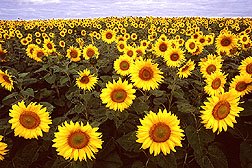This page has been archived and is being provided for reference purposes only. The page is no longer being updated, and therefore, links on the page may be invalid.
Pollinating Sunflowers: Big Job Is a Good Fit for the Right BeeBy Marcia WoodSeptember 27, 1999 When the job is pollinating crops, it might pay to bring in the specialists--especially those whose superior work habits offset the fact they're outnumbered 10 to one. An entomologist with the Agricultural Research Service has found that the sunflower leafcutting bee often does a better job pollinating sunflowers than the more common domesticated honey bee. In outdoor enclosures, one of the two kinds of sunflowers used in Vincent J. Tepedino's experiments produced larger and heavier seeds when pollinated by sunflower leafcutting bees. According to Tepedino, the sunflower leafcutting bees spread out evenly among the sunflowers rather than visiting just the plants nearest their nesting boxes. Tepedino is based at the ARS Bee Biology and Systematics Laboratory in Logan, Utah. The sunflower leafcutting bees, dark-brown to black insects about 3/4-inch to 1-inch long, are native to southern Canada and most of the United States. They are known to scientists as Megachile pugnata. The domesticated honey bee--originally from Europe-- is Apis mellifera. For the test, Tepedino used four 100-by-20-foot screened enclosures, owned by Pioneer Hi-Bred International, Inc., at Woodland, Calif. Each cage contained approximately 600 sunflower plants. For about 2-1/2 weeks, about 100 sunflower bees in each of two cages performed pollination chores. Meanwhile, a few thousand domestic honey bees--about 10 times more than the sunflower leafcutting bees--performed the same task in two other cages. The test was the first using sunflower leafcutting bees to pollinate hybrid sunflowers in field cages. Earlier work by other ARS researchers at Logan scrutinized the bees in open fields. For details, see the story in the current issue of the ARS magazine, Agricultural Research, and on the World Wide Web at: /is/AR/archive/sep99/sunf0999.htm ARS is USDA's chief research agency. Scientific contact: Vincent J. Tepedino, ARS Bee Biology and Systematics Laboratory, 5310 Old Main Hill, Logan, UT 84322; phone (435) 797-2559, fax (435) 797-0461, andrena@cc.usu.edu. |

